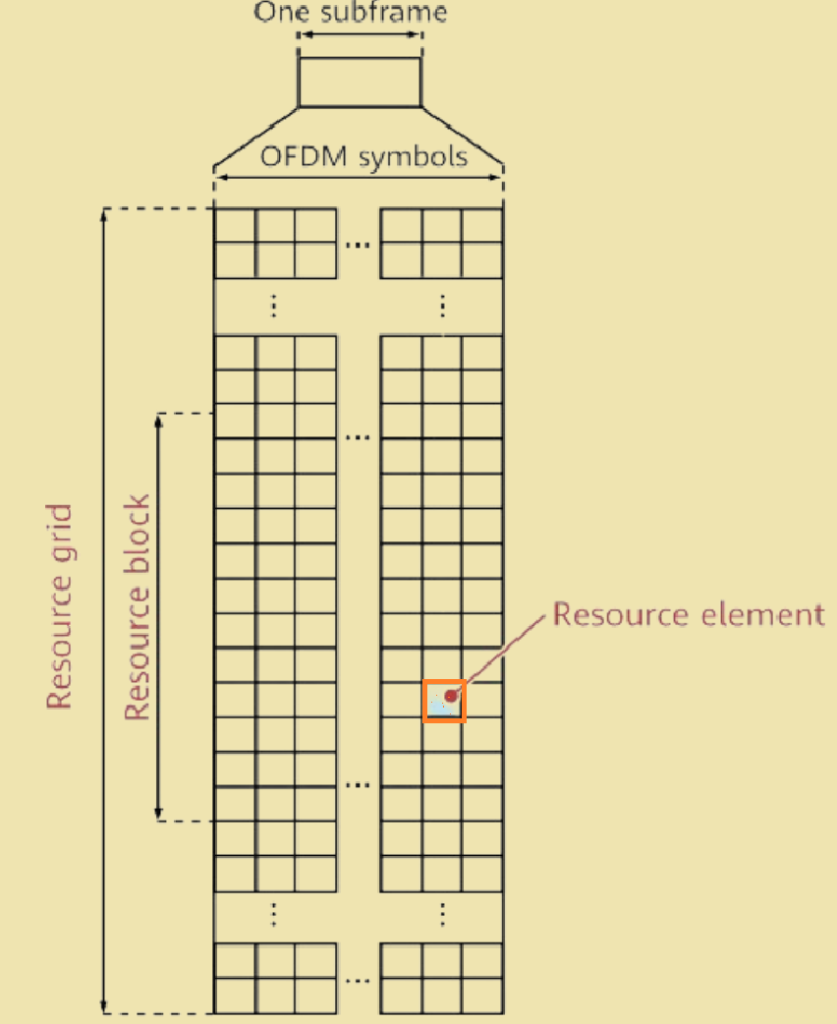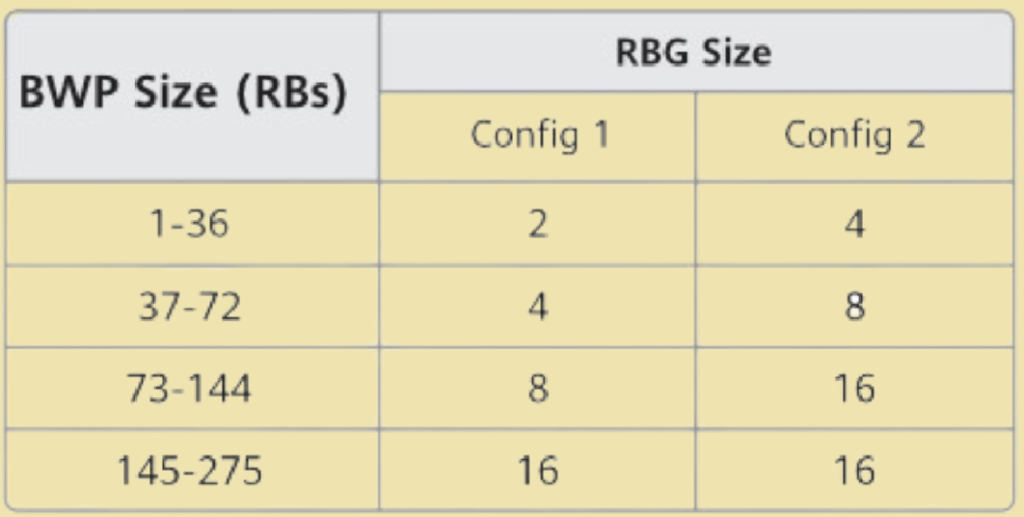Some concepts of frequency domain resources in 5G NR are similar to those in LTE, but some are newly introduced. We will introduce each individual concept.
Resource Element, Resource Block & Resource Group.
A resource element (RE) is the smallest granularity of 5G NR physical layer resources. Similar to that in LTE, an RE in 5G NR is one subcarrier in the frequency domain and one OFDM symbol in the time domain.
Read Also: What are Resource Blocks of LTE?
A resource block (RB) is the basic unit for allocating 5G NR channel resources in the frequency domain. In 5G NR, an RB contains 12 subcarriers in the frequency domain, just like in LTE. However, the RB bandwidth changes in 5G NR because the subcarrier spacing (SCS) is variable. In addition, the following should be specially noted:
- In LTE, an RB occupies one slot in the time domain, that is, seven OFDM symbols if the normal cyclic prefix (CP) is used, or six OFDM symbols if the extended CP is used. A subframe includes two slots in LTE, so the slot length is always 0.5 ms. The transmission time interval (TTI) in LTE scheduling is 1 ms, corresponding to two slots in the time domain. Therefore, the scheduling granularity in LTE is two RBs, or an RB pair, seen from the time domain. However, the time domain is usually ignored during RB statistics and calculation. For example, the number of RBs used in each TTI in a cell actually indicates the number of RB pairs.
- In 5G NR, 3GPP describes RBs only in the frequency domain but not in the time domain.
A resource grid (RG) is a set of time-frequency resources. In 5G NR, for each carrier with different numerologies, an RG includes all subcarriers in the frequency domain and all symbols in a subframe in the time domain. In addition, the start point of an RG in the frequency domain is determined at the RB level. Different numerologies correspond to different SCSs and one RB always contains 12 subcarriers. Therefore, the quantity of RBs in an RG varies with different numerologies, even though the transmission bandwidth remains the same. An RG is always one subframe in the time domain and RGs are defined separately in the uplink and downlink.
Figure below shows the resource allocation for an RE, RB, and RG.

Common Resource Block, Physical Resource Block & Resource Block Group.
A common resource block (CRB) can refer to any RB in 5G NR. CRBs are numbered from 0 and the center frequency of subcarrier 0 in CRB0 is called Point A. Point A will be described in subsequent sections.
In 5G NR, a physical resource block (PRB) refers to an RB contained in the BWP of a UE. PRBs are also numbered from 0. A PRB is the basic unit for data channel scheduling.
A resource block group (RBG) is a combination of PRBs in a BWP. RBGs are also numbered from 0. An RBG is the basic unit for data channel scheduling. An RBG can contain 2, 4, 8, or 16 PRBs. The specific number of PRBs depends on the number of RBs in a BWP and the configuration listed in Figure below.

Resource Element Group & Control Channel Element.
A resource element group (REG) is the basic unit of control channel resources. One REG occupies 12 subcarriers (equivalent to a PRB) in the frequency domain and one OFDM symbol in the time domain.
A control channel element (CCE) is the basic unit for control channel resource scheduling. One CCE consists of six REGs in the frequency domain.
Figure below shows the relationships between the REG and CCE.

Table below compares 5G NR and LTE in terms of frequency domain resources.
| Frequency Domain Concept | Involved in NR? | Involved in LTE? | Conceptual Differences Between NR and LTE | Remarks |
|---|---|---|---|---|
| RE | Yes | Yes | No difference | None |
| RB | Yes | Yes | No difference | The time-domain length of an RB in LTE is one slot, that is, 0.5 ms.In 5G NR, no clear explanation is provided for an RB in the time domain. |
| RG | Yes | Yes | No difference | The time-domain length of an RG in LTE is one slot, that is, 0.5 ms.The time-domain length of an RG in 5G NR is one subframe, that is, 1 ms. |
| CRB | Yes | No | A CRB is not defined in LTE. | None |
| PRB | Yes | Yes | No difference | None |
| RBG | Yes | Yes | No difference | None |
| REG | Yes | Yes | No difference | In LTE, one REG includes four REs. In 5G NR, one REG includes 12 REs. |
| CCE | Yes | Yes | No difference | In LTE, one CCE includes nine REGs. In 5G NR, one CCE includes six REGs. |
References.
- 3GPP TS 38.101-2, User Equipment (UE) radio transmission and reception; Part 1: Range 2 Standalone (Release 16)
- 3GPP TS 38.101-1, User Equipment (UE) radio transmission and reception; Part 1: Range 1 Standalone (Release 16)
- 3GPP TS 38.300, NR and NG-RAN Overall Description; Stage 2 (Release 16)
- 3GPP TS 38.104, Base Station (BS) radio transmission and reception (Release 16)
- 3GPP TS 38.213, Physical layer procedures for control (Release 16)
- 3GPP TS 38.211, Physical channels and modulation (Release 16)
- 3GPP TS 36.213, Physical layer procedures (Release 16)
- 3GPP TS 36.211, Physical channels and modulation (Release 14)
- 3GPP TR 38.912 (Release 15)
- 3GPP TR 38.802, Physical Layer Aspects (Release 14).
Interview Questions asked about 5G Frequency Domain Resources in telecom sector.
Q.1 What are the functions of the synchronization raster?
Q.2 Why synchronization raster is introduced to 5G NR?
Q.3 What is a bandwidth part (BWP)?
Q.4 Why are BWPs introduced in 5G NR?
Q.5 How does a UE obtain its BWP information from the network?
Q.6 What are the basic frequency domain resources in 5G NR?
Q.7 How do frequency domain resources differ from LTE?
Q.8 What are the duplex modes of the 5G NR frequency bands?
Q.9 Why does FR2 only operate in time division duplex (TDD)?